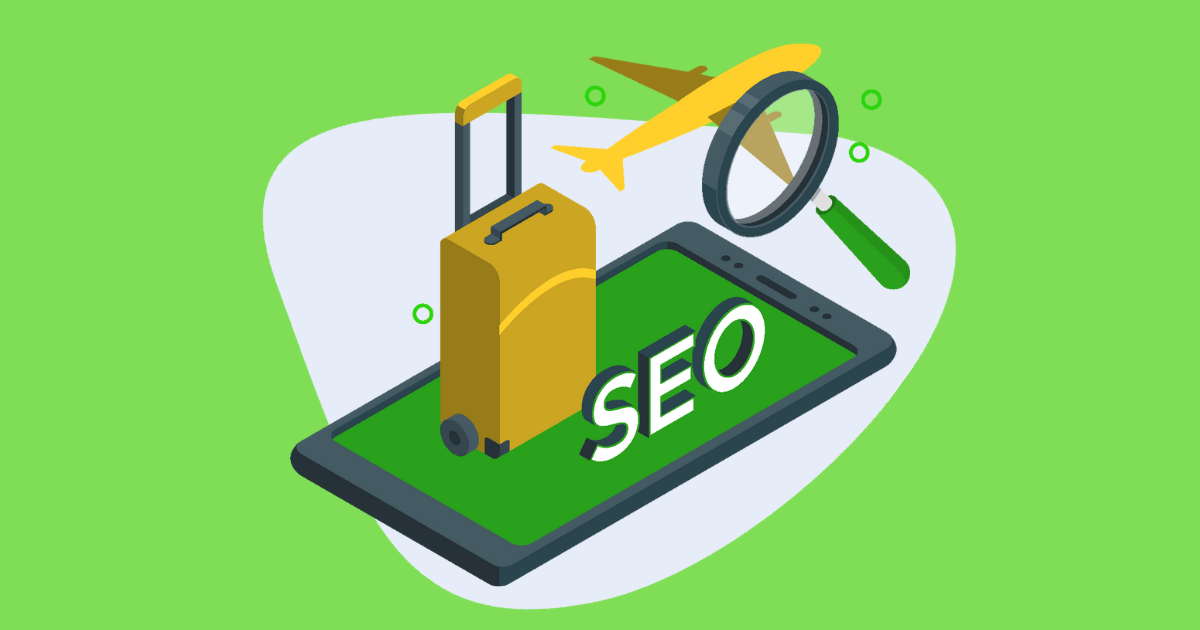According to recent reports, the global travel industry’s valuation is estimated to reach $2.29 trillion by 2023. This highlights the level of competition, and what companies have to do to win customers’ attention.
So how can you get an edge over your competitors? By improving your search engine visibility.
Besides word of mouth and brand recognition, organic search is one of the most important channels for travel companies because most travel plans begin with a Google search. Travel websites can capture customers throughout their entire buying journey – from dreaming up a trip to booking it – by employing tailored SEO techniques to achieve higher rankings on search engine result pages (SERPs).
However, before we can get to those strategies, we need to understand what separates travel sites from the rest of the web.
What Makes Travel Websites Different from Others?
Travel websites are unique in many ways. However, from an SEO standpoint, there are three key differences making travel sites challenging:
- They deal with a wide range of complex and diverse content – This includes destination information, hotel listings, flight schedules, and travel itineraries, making it necessary to implement advanced search options, sorting, filtering, and interactive maps to create better user experiences.
- These websites rely heavily on real-time data and integration with external systems – In many cases, travel websites use application programming interfaces (APIs) to fetch accurate flight information and often integrate third-party services for hotel bookings, car rentals, and tours.
- Travel websites make extensive use of JavaScript to enhance interactivity and provide dynamic functionalities – Features like dropdown menus, interactive calendars, auto-complete suggestions, and live updates are common JS-implemented features.
These differences present unique challenges for SEOs who need to optimize travel websites for search engine visibility and user engagement.
7 Ways to Boost SEO Performance of Tourism Websites
Although travel sites must follow Google’s guidelines and enterprise SEO best practices like any other big or dynamic website out there, optimizing sites in the tourism industry require a more focused approach to accommodate the specific needs of its niche. Let’s explore seven strategies every travel site needs to employ to ensure proper crawling and indexation and ensure higher ranking potentials:
1. Create a Travel-Focused Content Strategy
Although there are many ways to define the customer journey, we like the idea presented by Google about micro-moments, which they define as:
“…When people reflexively turn to a device – increasingly a smartphone – to act on a need to learn something, do something, discover something, watch something, or buy something. They are intent-rich moments when decisions are made and preferences shaped.”
No matter what definition you want to follow, the practical core is almost the same: you want to catch your audiences’ attention from where they start to research to the time they make a decision, and that’s the magic of SEO and content.
But… where do you start?
Follow Adido’s sales funnel
If you’re creating your content strategy from scratch, one of the best frameworks you can follow is Adido’s sales funnel adaptation to the travel industry:
In this funnel, there are four main micro-moments you want to capture through our site’s content:
- Dreaming moments – In this stage, the customer only has a broad idea of what she wants. It’s the start of a desire and a broad search due to, for example, a holiday: “best places to celebrate an anniversary” or “where to travel during summer break.”
- Planning moments – Now that she has a destination, let’s say Italy, she’ll start planning her trip. To capture these moments of planning, you need to create localized content like a “Places to enjoy in Italy during an X days trip” series, event pages with up-to-date information about carnivals, expositions, live events, etc., and flight/room pricing comparison pages.
- Booking moments – She’s ready to buy! And it means it’s time for localized landing pages (e.g., Room for Two in the Heat of Venice, Italy). In this stage, your landing pages are your sales team, showing all the necessary information about a flight, accommodation, or tour, allowing her to book it through your platform (or affiliate platform).
- Experience moments – It’s time to delight your customers. Show all the different things they can do after booking their trip with you. What’s there to see? what’s the best order? and more. These pages are also good for the planning stage of the funnel but differentiate for being more focalized on the converted lead than catching planners.
It’s important to remember that the customer journey is never linear.
Most people might first look for experiences in different places before actually looking for a specific destination, while others might impulsively look for a new trip before planning anything else.
That’s why you don’t need to implement the entire journey in order. If you have to choose, create money-making landing pages first (based on the places you serve or customers travel the most) and then create “supporting content” around those destinations to capture demand.
2. Optimize All SEO Elements on Individual Pages
What are these elements, you might ask? Here are the different SEO elements you must optimize:
- Meta title – This is the title of your page that’ll get displayed in Google search results. Having your primary keyword within the title will provide the first signal of what the page is about to search engines, but you’ll also have to make sure it’s catchy enough to entice a click from customers.
- Meta description – It is also displayed in search results, but it doesn’t have a direct effect on your ranking. Instead, it 100% impacts your click-through rate (CTR), so having a descriptive, brief explanation of the page’s value will help you catch more clicks, increasing organic performance.
- H1 heading – Your primary keyword should be included in this heading, as it encapsulates the entire topic of the page.
- Head structure – All sections of the page should be divided into H2 headings, and subsections should be tagged as H3 headings. You don’t need to repeat your primary keyword in then because if you’re following the topic, related keywords will bleed inside these headings organically.
- URL structure – URLs must be clean (don’t use symbols), readable (accurately representing the page’s content), and must include relevant keywords.
- Alt text – Every image must have an alternative text for accessibility reasons. Plus, it helps Google understand what your image is about, further signaling what’s the topic and how it fits in the content.
It sounds like a lot of work, but it is critical that Google can understand your page as easily as possible for proper categorization (a requirement before indexing your content). If Google, and other search engines, can’t categorize your content properly, it won’t appear on your target keyword result pages, missing the point of why the page exists.
3. Take Advantage of Seasonality
Something to have in mind when creating and implementing your content strategy is the importance of seasonality in the travel industry. There are just specific moments in the year people tend to travel more to certain destinations, and you can take advantage of this by being prepared with content around those periods.
But how do you know when it’s the right time, for search, to focus on a specific location?
To get this information, we can use Google Trends to have a look at our keywords across the years.
This way, we can see when searching interest spikes most often. Here’s a simple example – and kinda obvious example:
As you can imagine, this keyword always gets more popular in February, as it’s when there’s the most interest in the topic.
You can do the same thing with all the keywords you’d like to target. Also think about holidays and vacation times – for example, maybe summer break it’s a great time for family trip content and campaigns.
4. Create a Scalable Site Structure
More flights, more hotel rooms, more trips… There are way too many pages to handle manually, and that’s without considering all the dynamic pages that are getting generated by APIs.
To properly handle the volume of pages, travel websites need to create a series of rules to ensure proper optimization at scale and automate as much of the process as possible:
- Define your categories – Group your pages by type (e.g., landing pages, booking pages, and blog posts), destination (e.g., Italy, France, Spain, US, etc.), and topic (this is mostly for blog pages), allowing you to segment your content into silos instead of having the same piece on five different category pages.
- Add breadcrumbs – These links can show the different paths/clicks a user has made to get to the current page or help users orient themselves through categories.
- Plan your main navigation – These are the links that crawlers can follow from the homepage to the content, making the main navigation menu a reflection of your site structure.
- Create URL logic – Automating URL generation can save your site from very terrible slugs, inconsistencies, and mistakes. A potential way to do this is by taking information from the page’s title or any other predictable information found in the source of information you’re using.
A clear site structure will also help search engines find your pages more efficiently (improved crawlability) and speed up the indexing of your site.
5. Use the Right Schema Markup
Schema markup allows you to provide more context to search engines about your travel content in a format search bots can understand.
By using specific schema types related to travel (like trip schema or location schema), you help search engines understand the nature of your content and its relevance to user queries, leading to more accurate and targeted search results and ensuring that your travel site reaches the right audience.
You can check our guide on structured data in SEO for a more detailed walkthrough of how to use schemas, but here are a few of the travel-related schemas you could start exploring:
- TouristTrip – “A created itinerary of visits to one or more places of interest (TouristAttraction/TouristDestination) often linked by a similar theme, geographic area, or interest to a particular touristType.”
- Event – “An event happening at a certain time and location, such as a concert, lecture, or festival. Ticketing information may be added via the offers property.”
- HotelRoom – “A hotel room is a single room in a hotel.”
- Flight – “An airline flight.”
If you’ve never seen schema markup before, here’s a flight schema example:
| <script type=”application/ld+json”> { “@context”: “https://schema.org/”, “@type”: “Flight”, “flightNumber”: “ABC123”, “departureAirport”: { “@type”: “Airport”, “name”: “Departure Airport”, “iataCode”: “ABC” }, “arrivalAirport”: {“@type”: “Airport”, “name”: “Arrival Airport”, “iataCode”: “XYZ” }, “departureTime”: “2023-07-01T09:00:00-07:00”, “provider”: {“@type”: “Organization”, “name”: “Airline Name”}, “price”: “100.00”, “priceCurrency”: “USD” } </script> |
6. Use Prerender to Solve Rendering Issues and Increase Core Web Vitals
As mentioned before, travel sites use JavaScript a lot on their pages.
The biggest names usually build their sites using front-end technologies like React, Vue, or Angular, which allow for more interactive and user-friendly experiences. But search engines don’t share the same appreciation.
JavaScript makes it harder for search engines to crawl and index your pages because they don’t interact with your pages the same way customers do.
Search bots need to add an extra step to render your JavaScript content which requires 9x more crawl budget than static pages, and of course, as the rendering takes longer, it also negatively affects your page speed scores, including response time and core web vitals (CWVs).
All of these complications result in missing content due to partially rendered pages, undiscovered pages because of a depleted crawl budget, long waiting times for indexation, and lower rankings.
To solve all these problems in a couple of hours, just install Prerender’s middleware and submit an updated sitemap.
Prerender will crawl your site and cache a fully rendered and functional version of your pages. This includes content pulled from external APIs – making them 100% index-ready.
From there on, Prerender will deliver your rendered page to any search bot requesting it in 0.03s on average, scoring near-perfect CWVs, and solving/preventing any JS-related SEO issue from its root.
7. Use Hreflang Tags on Localized Pages
Travel sites tend to serve more than one country, so it’s common to localized pages by translating them into their audiences’ language. However, a common mistake is thinking that’s the only thing they need to do to gain traffic from those locations.
If all you do is translate your pages, search engines will have a hard time understanding the relationship between pages in one language and another and might even consider it as a spam tactic.
Hreflang tags are “HTML attribute(s) meant to tell search engines the relationship between different versions of a page that are targeting specific languages and/or locations.”
This way, you can avoid causing duplicate or spammy content issues and provide Google with the necessary signals to start ranking on related keywords in your target language and location.
Usually, these tags are implemented within the <head> section of your page:
| <link rel=”alternate” href=”https://example.com” hreflang=”en-us” /> |
However, because travel sites tend to be so big, adding this information to every page can be too messy and prompt to mistakes.
Instead, a better alternative is adding this information to your sitemap like this:
| <url> <loc>https://prerender.io/react/</loc> <xhtml:link rel=”alternate” hreflang=”de” href=”https://prerender.io/deutsch/react/“/> <xhtml:link rel=”alternate” hreflang=”de-ch” href=”https://prerender.io/schweiz-deutsch/react/“/> <xhtml:link rel=”alternate” hreflang=”en” href=”https://prerender.io/react/“/> </url> |
Hreflang tags will give you more control over the different versions of your pages and prevent the potential indexing problems.
Wrapping Up
If you follow these seven strategies, you’ll have won 80% of the battle, and you’ll be closer to achieving your organic goals.
However, if your site is built using JavaScript frameworks to add extra functionality – which is needed to stay competitive – the fastest way to gain an edge on your competitors is by taking care of the rendering process.
Most metadata like titles, descriptions, hreflang, and schema are more often than not delivered dynamically. In other words, the page needs to be rendered before search engines can gain access to this information.
This presents a problem when most search engines can’t handle JS, while those that can are so prompt to mistakes they recommend using rendering alternatives.
Installing Prerender takes a couple of hours and will take over rendering automatically without any maintenance or extra work from your end, solving your rendering issues from their root.
Ready to experience 100x+ page load speed improvement and perfect indexing every time?



